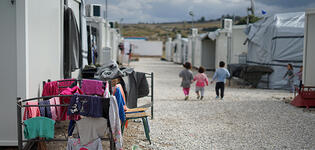Blog
Young Afghan refugees and asylum seekers in the UK
Does more education mean better futures?
Education is my freedom ... if I have my education, everything is still possible for me in the future.
Mohammed grinned, and looked down at his newly acquired university student card. He’d just enrolled for his first term at university as the beneficiary of a scholarship for asylum-seeking young people classed as international students and unable to pay fees or cover living expenses. At that moment, after years of struggle, the future was looking brighter.
Mohammed arrived in the UK from Afghanistan as an unaccompanied asylum-seeking child (UASC) aged 14, and, like all UASC in the UK, was looked after by a local authority until he turned 18. An unprecedented number of UASC have arrived in Europe over the last decade, and young Afghans make up the largest group of these children in the UK. Despite a wealth of UK policies aimed at ensuring positive outcomes for young people who have been through the care system, less is known about their experiences after they reach the age of eighteen. Research conducted by Refugee Support Network within a UNU-WIDER research project sheds new light on the important role of educational achievement in creating socioeconomic opportunities for young people like Mohammed, and highlights the problematic and pervasive influence of unresolved immigration status. The future, it suggests, may not be as bright as Mohammed hopes.
Young Afghans in the UK
Very few Afghan UASCs are granted refugee status in the UK. The majority are granted a temporary form of leave, formerly ‘Discretionary Leave to Remain’ — more recently UASC Leave, which allows them to remain in the UK until they reach the age of 18. At the age of 17.5 years, they begin a protracted process of applying for extended leave to remain in the UK — many are refused, and risk being forced to return to Afghanistan. Since 2007, just over 2,000 care leavers have been forcibly removed to Afghanistan, and increasing numbers remain in limbo in the UK after being refused asylum and having exhausted all their rights to appeal. As such, Afghan care leavers in the UK present as a particularly vulnerable group among migrants and raise particular concerns in terms of integration and wellbeing.
Educational profiles of young Afghans in the UK
Unaccompanied minors face considerable educational disadvantage in the UK. Our research found that where qualifications have been gained by Afghan UASC care leavers, the majority remain at the basic level, with entry-level (pre-GCSE) qualifications only, and very few have progressed beyond Level 1-2 (equivalent to GCSE). However, data collated on entrance to higher education in the last three years shows that there is a small but significant minority who excel academically, achieving high levels of education despite substantial disadvantage.
The impact of education on employment
Higher levels of education have helped Afghan care leavers transition from the low-skilled and manual labour work common amongst those with basic level qualifications only, into customer-facing roles in retail, personal services and restaurants. When university-level qualifications are gained, skilled work in the public and private sector has become accessible to over half of those with both this level of qualification and the right to work.
Higher levels of education have also facilitated access to the formal labour market. While in the asylum process, asylum seekers in the UK do not have the right to work, and so many young Afghans are active only in the informal economy. However, even when granted the right to work, a notable proportion of Afghan care leavers report remaining unable to transition to the formal labour market. Those with higher levels of education, in contrast, appear better equipped with the critical thinking and investigative skills (commonly associated with higher levels of education) needed to navigate the transition to working legally.
The impact of education on pay
The minimum wage in the UK is £7.05 per hour, and, in recognition of the higher costs of living in the capital, a London Living Wage is £9.45 per hour, while not legally enforced, is recommended. Although remuneration does improve with each level of education achieved, we found for the Afghan care leavers consulted that it remains significantly below the national averages, at every level of educational qualification. At the basic level of education, not a single respondent was paid the UK minimum wage, with a significant minority receiving only £3 per hour. At the further and higher education level, remuneration improves significantly for Afghan care leavers. Amongst those with the right to work, all are paid at the minimum wage or above, with the majority paid the London Living Wage or higher (whether or not they are based in London).
The elephant in the room – immigration status
The data analysed in this new research demonstrate that there is a positive correlation between higher levels of education and improved socioeconomic outcomes for Afghan care leavers across regions of England, particularly beyond basic education. However, the data also reveal that, in every region of the UK except one, the majority of Afghan care leavers are living with unstable immigration status — and that this limits, or in some cases entirely negates the benefits of education.
Precarious immigration status has been shown to both lead to and exacerbate mental health difficulties and anxiety, create significant barriers to progression in education and preclude working legally. There is, therefore, a notable group of young care leavers in the UK, who, as a result of their immigration status, are not able to transition into the ‘secure and settled futures’ which the government aspire to for care leavers more broadly.
What future for these young people?
Mohammed is one of the majority of Afghan care leavers living with precarious immigration status. He is able to study at university because of his scholarship, but still does not have the right to work, and, despite having spent formative years as a looked-after child in the UK care system, could ultimately be forced to return to Afghanistan. When this happens, outcomes are poor at best, with young people facing significant violence, high levels of destitution, severe mental health difficulties, and notable barriers entering any kind of education or employment.
If he remains living in protracted limbo in the UK, with the formal labour market out of reach, Mohammed and those like him become increasingly vulnerable to mental health issues, exploitative work conditions, and a growing sense of powerlessness and frustration — even when they have achieved high levels of education. The state also loses out. The majority of these young people aspire to do meaningful work, to contribute to society and, in many cases, to proactively seek work that improves the lives of others — and yet are prevented from doing so.
For those with stable and more permanent forms of immigration status, additional support is still needed in order to adjust for the psychological and practical impact of the years spent awaiting this. The provision of business networking opportunities to build social capital; training in entrepreneurship and start-up skills tailored to each level of education; and improved access to ongoing mental health support may begin to reduce the gap in socioeconomic wellbeing between young Afghans and their peers.
In-text reference
Association of Directors of Children’s Services Ltd. 2016. Unaccompanied Asylum Seeking and Refugee Children. Safeguarding Pressures Phase 5 – Special Thematic Report. ADCS: Manchester, UK.
HM Government. 2013. Care Leaver Strategy: A cross-departmental strategy for young people leaving care. Department of Education: London, UK.
Refugee Council. 2017. Asylum Statistics Annual Trends. Refugee Council Information February 2017. BRC: Stratford, UK.
Refugee Support Network. 2016. After Return: Documenting the Experiences of Young People Forcibly Removed to Afghanistan. RSN: London, UK.
Refugee Council. 2013. A lot to learn: refugees, asylum seekers and post-16 learning. BRC: Stratford, UK.
UNHCR. 2017. Refugee and Migrant Children in Europe: Accompanied, Unaccompanied and Separated.
The views expressed in this piece are those of the author(s), and do not necessarily reflect the views of the Institute or the United Nations University, nor the programme/project donors.
 Join the network
Join the network





